fuel Citroen DS4 RHD 2013.5 1.G Owner's Manual
[x] Cancel search | Manufacturer: CITROEN, Model Year: 2013.5, Model line: DS4 RHD, Model: Citroen DS4 RHD 2013.5 1.GPages: 400, PDF Size: 31.86 MB
Page 5 of 400

MULTIFUNCTION
SCREENSCOMFORT ACCESS VISIBILITY
64 Monochrome screen C
68 Colour screen
70 Tr i p c o m p u t e r78 Ventilation
80 Manual air conditioning
82 Dual-zone digital air
conditioning
86 Front demist - defrost
87 Rear screen demist - defrost
88 Front seats
92 Rear seats
93 Steering wheel adjustment
94 Mirrors100 Remote control key
110 Alarm
113 Doors
115 Boot
116 Electric windows
118 Fuel tank
121 Misfuel prevention
(Diesel)124 Lighting controls
125 Daytime running lamps
128 Automatic illumination of
headlamps
129 Welcome lighting
130 Headlamp adjustment
131 Directional lighting
133 Wiper controls
13 4 Automatic rain sensitive
wipers
138 Courtesy lamps
139 Interior mood lighting
14 0 Boot lamp
004004005005002002003003
Page 7 of 400

CHECKS PRACTICAL
INFORMATIONTECHNICAL DATA AUDIO AND
TELEMATICS
235 Bonnet
236 Running out of fuel (Diesel)
237 Petrol engines
238 Diesel engines
239 Checking levels
242 Checks248 Temporary puncture repair
kit
253 Changing a wheel
260 Snow chains
261 Changing a bulb
268 Changing a fuse
274 12 V battery
278 Energy economy mode
279 Changing a wiper blade
279 Very cold climate screen
280 Fitting roof bars
281 Towing the vehicle
283 Towing a trailer
285 Accessories290 Petrol engines
291 Petrol weights
292 Diesel engines
293 Diesel weights
294 Dimensions
295 Identifi cation markings299 Emergency or assistance
301 eMyWay
355 Audio system
012012013013010010011011
Page 10 of 400
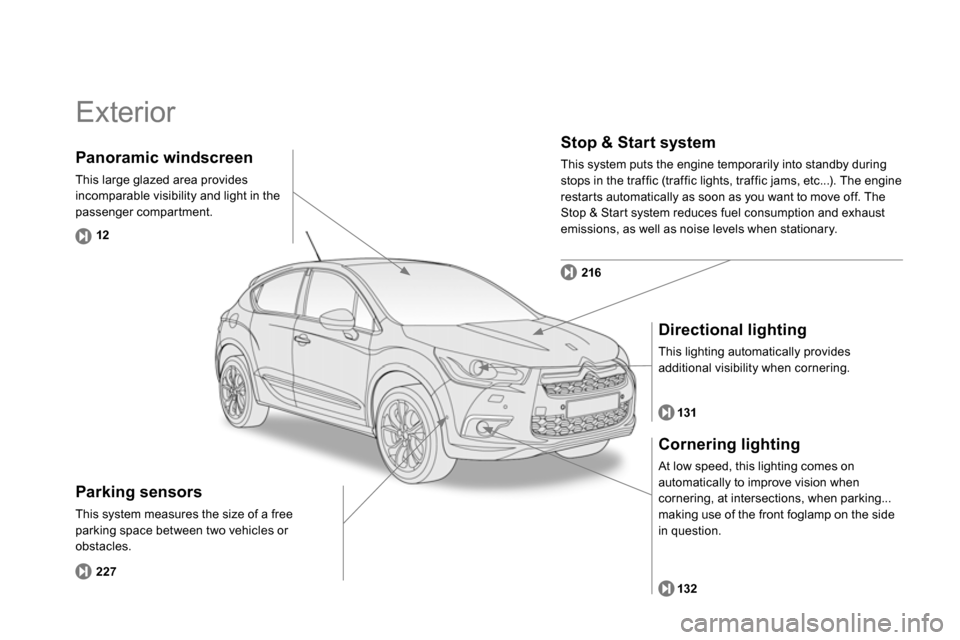
Exterior
Parking sensors
This system measures the size of a free
parking space between two vehicles or
obstacles.
Stop & Start system
This system puts the engine temporarily into standby during
stops in the traffic (traffic lights, traffic jams, etc...). The engine
restarts automatically as soon as you want to move off. The
Stop & Start system reduces fuel consumption and exhaust
emissions, as well as noise levels when stationary.
227
216
Directional lighting
This lighting automatically provides
additional visibility when cornering.
131
Panoramic windscreen
This large glazed area provides
incomparable visibility and light in the
passenger compartment.
12
Cornering lighting
At low speed, this lighting comes on
automatically to improve vision when
cornering, at intersections, when parking...
making use of the front foglamp on the side
in question.
132
Page 13 of 400

11Familiarisation
118 , 12 1
A.
Opening the fuel filler flap.
Capacity of the fuel tank: approximately 60 litres.
Fuel tank
Opening
101, 115
1.
Selective unlocking of the boot.
2.
Opening the boot.
Boot
Page 16 of 400
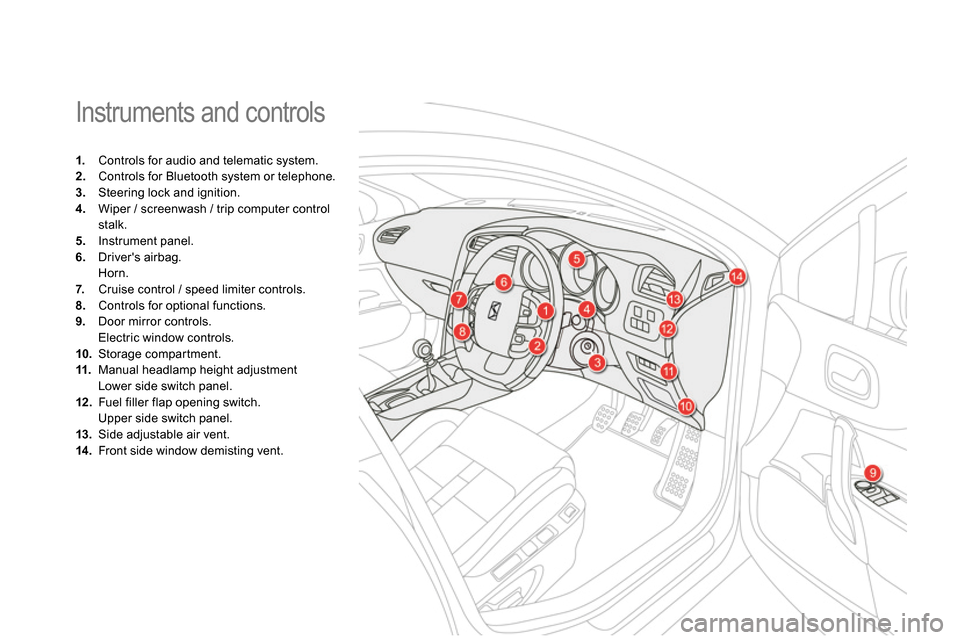
Instruments and controls
1.
Controls for audio and telematic system.
2.
Controls for Bluetooth system or telephone.
3.
Steering lock and ignition.
4.
Wiper / screenwash / trip computer control
stalk.
5.
Instrument panel.
6.
Driver's airbag.
Horn.
7.
Cruise control / speed limiter controls.
8.
Controls for optional functions.
9.
Door mirror controls.
Electric window controls.
10.
Storage compartment.
11.
Manual headlamp height adjustment
Lower side switch panel.
12 .
Fuel filler flap opening switch.
Upper side switch panel.
13.
Side adjustable air vent.
14 .
Front side window demisting vent.
Page 25 of 400

23Familiarisation
Monitoring
A.
With the ignition on, the bars indicate the
level of fuel remaining.
B.
With the engine running, its associated low
level warning lamp should go off.
C.
With the ignition on, the oil level indicator
should show for a few seconds that the
level is OK or correct, depending on
version.
If the levels are not correct, top up the levels
which are low.
Gauges
38
1.
With the ignition on, the orange and red
warning lamps come on.
2.
With the engine running, these warning
lamps should go off.
If warning lamps remain on, refer to the page
concerned.
Warning lamps
43
A.
Make an emergency call.
Central switch panels
17 7, 2 9 9
B.
Access to CITROËN ser vices.
17 7, 2 9 9
C
. Hazard warning.
176
D
. Central locking.
108
E . Black panel (black screen).
60
Page 29 of 400
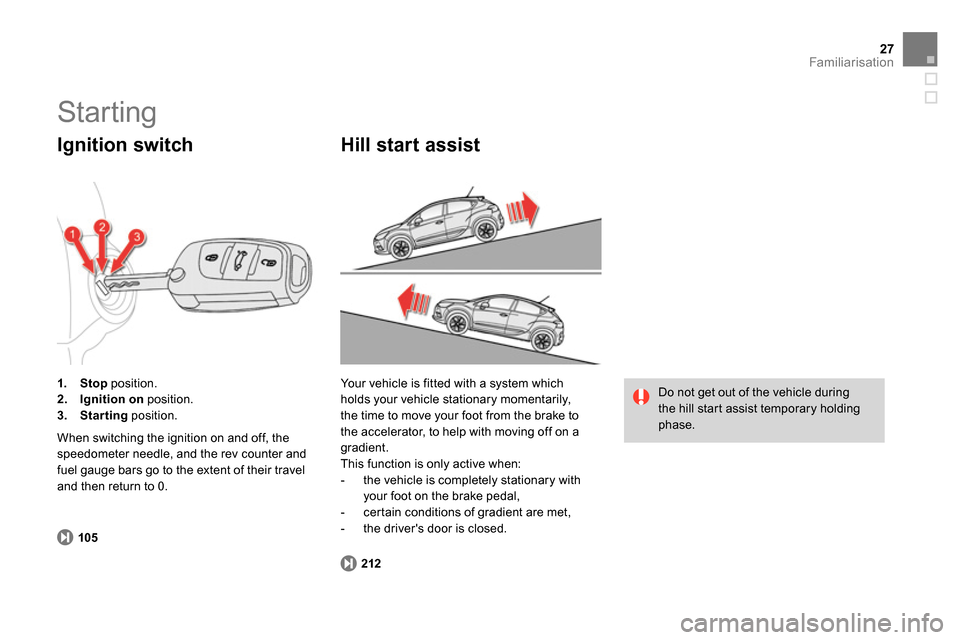
27Familiarisation
105
1.
Stop
position.
2.
Ignition on
position.
3.
Starting
position.
Ignition switch
When switching the ignition on and off, the
speedometer needle, and the rev counter and
fuel gauge bars go to the extent of their travel
and then return to 0.
Starting
Your vehicle is fitted with a system which
holds your vehicle stationary momentarily,
the time to move your foot from the brake to
the accelerator, to help with moving off on a
gradient.
This function is only active when:
- the vehicle is completely stationary with
your foot on the brake pedal,
- certain conditions of gradient are met,
- the driver's door is closed.
212
Do not get out of the vehicle during
the hill start assist temporary holding
phase.
Hill start assist
Page 33 of 400

31Familiarisation
Stop & Start
Engine going into STOP mode
216
The "ECO"
warning lamp comes on in
the instrument panel and the engine is
automatically put into standby:
- with a manual gearbox;
at speeds below
12 mph (20 km/h), when you put the gear
lever into neutral and release the clutch
pedal,
- with an electronic gearbox;
at speeds
below 5 mph (8 km/h), when you press
the brake pedal or put the gear lever in
position N
.
Engine going into START mode
Deactivation / Reactivation
You can deactivate the system at any time by
pressing the "ECO OFF"
button; the button's
warning lamp comes on.
217
217
The system is reactivated automatically
every time you start the engine with
the key.
Before refuelling or doing anything
under the bonnet, you must switch off
the ignition with the key. The "ECO"
warning lamp goes off
and the engine restarts automatically:
- with a manual gearbox;
when you fully
depress the clutch pedal,
- with an electronic gearbox;
●
with the gear lever in position A
or M
,
when you release the brake pedal,
●
or gear lever in position N
and brake
pedal released, when you change to
position A
or M
,
●
or when you engage reverse.
In certain circumstances the STOP mode may
not be available; the "ECO"
warning lamp
flashes for a few seconds then goes off. In certain condition, START mode may engage
automatically; the "ECO"
warning lamp flashes
then goes off.
Driving safely
Page 36 of 400
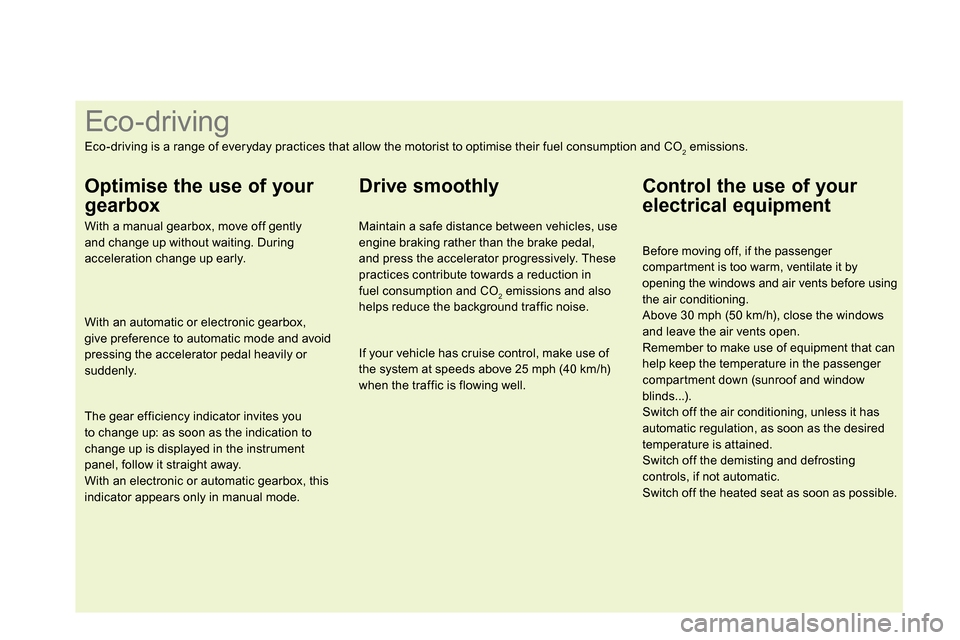
Eco-driving
Eco-driving is a range of everyday practices that allow the motorist to optimise their fuel consumption and CO2 emissions.
Optimise the use of your
gearbox
With a manual gearbox, move off gently
and change up without waiting. During
acceleration change up early.
With an automatic or electronic gearbox,
give preference to automatic mode and avoid
pressing the accelerator pedal heavily or
suddenly.
The gear efficiency indicator invites you
to change up: as soon as the indication to
change up is displayed in the instrument
panel, follow it straight away.
With an electronic or automatic gearbox, this
indicator appears only in manual mode.
Drive smoothly
Maintain a safe distance between vehicles, use
engine braking rather than the brake pedal,
and press the accelerator progressively. These
practices contribute towards a reduction in
fuel consumption and CO
2 emissions and also
helps reduce the background traffic noise.
If your vehicle has cruise control, make use of
the system at speeds above 25 mph (40 km/h)
when the traffic is flowing well.
Control the use of your
electrical equipment
Before moving off, if the passenger
compartment is too warm, ventilate it by
opening the windows and air vents before using the air conditioning. Above 30 mph (50 km/h), close the windows
and leave the air vents open.
Remember to make use of equipment that can
help keep the temperature in the passenger
compartment down (sunroof and window
blinds...).
Switch off the air conditioning, unless it has
automatic regulation, as soon as the desired
temperature is attained.
Switch off the demisting and defrosting
controls, if not automatic.
Switch off the heated seat as soon as possible.
Page 37 of 400
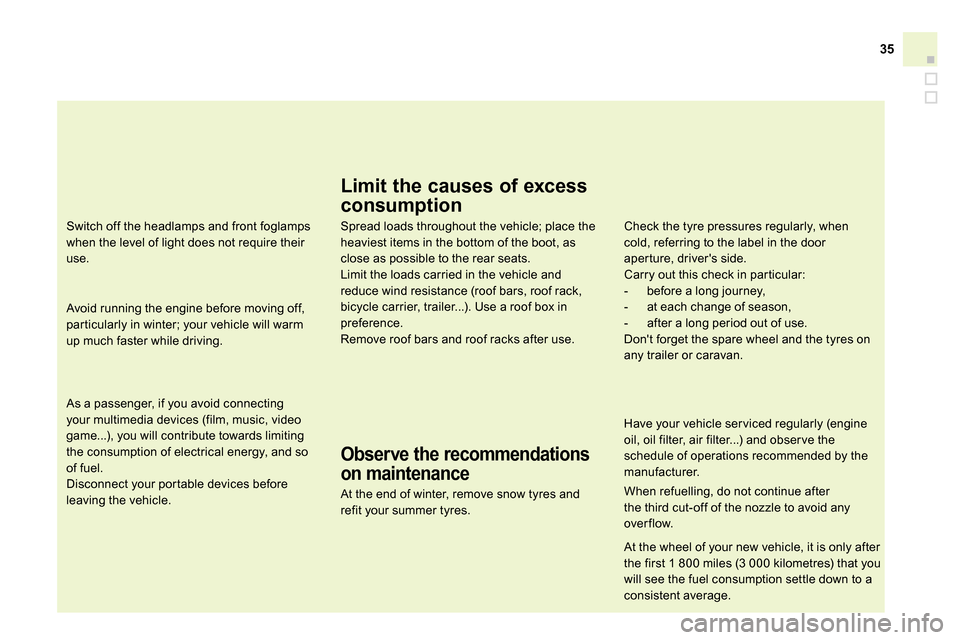
35
As a passenger, if you avoid connecting
your multimedia devices (film, music, video
game...), you will contribute towards limiting
the consumption of electrical energy, and so
of fuel.
Disconnect your portable devices before
leaving the vehicle.
Limit the causes of excess
consumption
Spread loads throughout the vehicle; place the
heaviest items in the bottom of the boot, as
close as possible to the rear seats.
Limit the loads carried in the vehicle and
reduce wind resistance (roof bars, roof rack,
bicycle carrier, trailer...). Use a roof box in
preference.
Remove roof bars and roof racks after use.
At the end of winter, remove snow tyres and
refit your summer tyres.
Observe the recommendations
on maintenance
Check the tyre pressures regularly, when
cold, referring to the label in the door
aperture, driver's side.
Carry out this check in particular:
- before a long journey,
- at each change of season,
- after a long period out of use.
Don't forget the spare wheel and the tyres on
any trailer or caravan.
Have your vehicle ser viced regularly (engine
oil, oil filter, air filter...) and obser ve the
schedule of operations recommended by the
manufacturer.
When refuelling, do not continue after
the third cut-off of the nozzle to avoid any
over flow.
Switch off the headlamps and front foglamps
when the level of light does not require their
use.
Avoid running the engine before moving off,
particularly in winter; your vehicle will warm
up much faster while driving.
At the wheel of your new vehicle, it is only after
the first 1 800 miles (3 000 kilometres) that you
will see the fuel consumption settle down to a
consistent average.